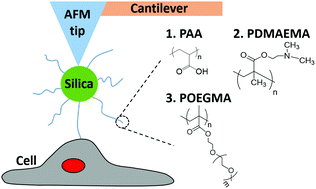当前位置:
X-MOL 学术
›
Soft Matter
›
论文详情
Our official English website, www.x-mol.net, welcomes your
feedback! (Note: you will need to create a separate account there.)
The physico-chemistry of adhesions of protein resistant and weak polyelectrolyte brushes to cells and tissues.
Soft Matter ( IF 2.9 ) Pub Date : 2020-01-02 , DOI: 10.1039/c9sm01403a Edward J Cozens 1 , Dexu Kong , Nima Roohpour , Julien E Gautrot
Soft Matter ( IF 2.9 ) Pub Date : 2020-01-02 , DOI: 10.1039/c9sm01403a Edward J Cozens 1 , Dexu Kong , Nima Roohpour , Julien E Gautrot
Affiliation

|
The non-specific adhesion of polymers and soft tissues is of great interest to the field of biomedical engineering, as it will shed light on some of the processes that regulate interactions between scaffolds, implants and nanoparticles with surrounding tissues after implantation or delivery. In order to promote adhesion to soft tissues, a greater understanding of the relationship between polymer chemistry and nanoscale adhesion mechanisms is required. In this work, we grew poly(dimethylaminoethyl methacrylate) (PDMAEMA), poly(acrylic acid) (PAA) and poly(oligoethylene glycol methacrylate) (POEGMA) brushes from the surface of silica beads, and investigated their adhesion to a variety of substrates via colloidal probe-based atomic force microscopy (AFM). We first characterised adhesion to a range of substrates with defined surface chemistry (self-assembled monolayers (SAMs) with a range of hydrophilicities, charge and hydrogen bonding), before studying the adhesion of brushes to epithelial cell monolayers (primary keratinocytes and HaCaT cells) and soft tissues (porcine epicardium and keratinized gingiva). Adhesion assays to SAMs reveal the complex balance of interactions (electrostatic, van der Waals interactions and hydrogen bonding) regulating the adhesion of weak polyelectrolyte brushes. This resulted in particularly strong adhesion of PAA brushes to a wide range of surface chemistries. In turn, colloidal probe microscopy on cell monolayers highlighted the importance of the glycocalyx in regulating non-specific adhesions. This was also reflected by the adhesive properties of soft tissues, in combination with their mechanical properties. Overall, this work clearly demonstrates the complex nature of interactions between polymeric biomaterials and biological samples and highlights the need for relatively elaborate models to predict these interactions.
中文翻译:

蛋白抗性和弱聚电解质刷与细胞和组织的粘附的物理化学。
聚合物和软组织之间的非特异性粘附对生物医学工程领域非常感兴趣,因为它将阐明在植入或输送后调节支架,植入物和纳米颗粒与周围组织之间相互作用的某些过程。为了促进对软组织的粘附,需要对聚合物化学和纳米级粘附机制之间的关系有更深入的了解。在这项工作中,我们从二氧化硅微珠的表面生长了聚甲基丙烯酸二甲基氨基乙基酯(PDMAEMA),聚丙烯酸(PAA)和聚甲基丙烯酸低聚乙二醇(POEGMA)刷,并研究了它们对各种基材的粘附性通过基于胶体探针的原子力显微镜(AFM)。在研究刷子对上皮细胞单层(原发角质形成细胞和HaCaT细胞)的粘附力之前,我们首先用定义的表面化学(具有一定范围的亲水性,电荷和氢键的自组装单层(SAMs))表征了对多种基底的粘附力。和软组织(猪心外膜和角化牙龈)。对SAM的附着力测定揭示了相互作用的复杂平衡(静电,范德华相互作用和氢键)调节了弱聚电解质电刷的粘附力。这导致PAA刷与各种表面化学物质的附着力特别强。反过来,在细胞单层上的胶体探针显微镜突出显示了糖萼在调节非特异性粘附中的重要性。软组织的粘合特性也反映了这一点,结合其机械性能。总的来说,这项工作清楚地证明了聚合生物材料与生物样品之间相互作用的复杂性,并强调了需要相对复杂的模型来预测这些相互作用。
更新日期:2020-01-02
中文翻译:

蛋白抗性和弱聚电解质刷与细胞和组织的粘附的物理化学。
聚合物和软组织之间的非特异性粘附对生物医学工程领域非常感兴趣,因为它将阐明在植入或输送后调节支架,植入物和纳米颗粒与周围组织之间相互作用的某些过程。为了促进对软组织的粘附,需要对聚合物化学和纳米级粘附机制之间的关系有更深入的了解。在这项工作中,我们从二氧化硅微珠的表面生长了聚甲基丙烯酸二甲基氨基乙基酯(PDMAEMA),聚丙烯酸(PAA)和聚甲基丙烯酸低聚乙二醇(POEGMA)刷,并研究了它们对各种基材的粘附性通过基于胶体探针的原子力显微镜(AFM)。在研究刷子对上皮细胞单层(原发角质形成细胞和HaCaT细胞)的粘附力之前,我们首先用定义的表面化学(具有一定范围的亲水性,电荷和氢键的自组装单层(SAMs))表征了对多种基底的粘附力。和软组织(猪心外膜和角化牙龈)。对SAM的附着力测定揭示了相互作用的复杂平衡(静电,范德华相互作用和氢键)调节了弱聚电解质电刷的粘附力。这导致PAA刷与各种表面化学物质的附着力特别强。反过来,在细胞单层上的胶体探针显微镜突出显示了糖萼在调节非特异性粘附中的重要性。软组织的粘合特性也反映了这一点,结合其机械性能。总的来说,这项工作清楚地证明了聚合生物材料与生物样品之间相互作用的复杂性,并强调了需要相对复杂的模型来预测这些相互作用。











































 京公网安备 11010802027423号
京公网安备 11010802027423号